 "ttyymmnn" (ttyymmnn)
"ttyymmnn" (ttyymmnn)
12/13/2016 at 12:35 • Filed to: planelopnik, planelopnik history
 11
11
 24
24
 "ttyymmnn" (ttyymmnn)
"ttyymmnn" (ttyymmnn)
12/13/2016 at 12:35 • Filed to: planelopnik, planelopnik history |  11 11
|  24 24 |
Welcome to This Date in Aviation History , getting of you caught up on milestones, important historical events and people in aviation from December 10 through December 13.
!!! UNKNOWN CONTENT TYPE !!!

December 11, 2009 – The first flight of the Airbus A400M Atlas. Ever since its first flight in 1954, the !!!error: Indecipherable SUB-paragraph formatting!!! has been the king of tactical airlift, a remarkable workhorse of an aircraft that has been continuously produced for over 60 years. But that record of success didn’t stop aircraft designers from trying to find a replacement for the venerable Herk. Development of the A400M began in 1982 when a consortium of aircraft manufacturers including the French Aérospatiale, British Aerospace, Lockheed and Messerschmitt-Bölkow-Blohm formed a group to develop what was called the Future International Airlifter to replace older the Hercules, as well as the smaller, twin-engine the !!!error: Indecipherable SUB-paragraph formatting!!! . The new tactical airlifter would fit somewhere in between the C-130 and the much larger !!!error: Indecipherable SUB-paragraph formatting!!! strategic airlifter, with the idea being to create an aircraft that could carry a heavier load than the C-130 while still operating from airstrips that cannot be used by the C-17. International politics being what they are, and with competing interests in the requirements of the new aircraft, Lockheed eventually left the group to develop the upgraded !!!error: Indecipherable SUB-paragraph formatting!!! , and other European nations came and went, and the remaining countries were organized under the banner of !!!error: Indecipherable SUB-paragraph formatting!!! . One of the first problems Airbus Military faced was the lack of an existing turboprop engine that would provide the necessary performance. After making a request for proposals, the consortium received replies from both Pratt & Whitney Canada with their !!!error: Indecipherable SUB-paragraph formatting!!! , and Europrop International with their !!!error: Indecipherable SUB-paragraph formatting!!! . As a result of perhaps more European political intrigue, the Europrop engine was selected. The TP400 engine produces 11,000 hp each and provides a maximum speed of 513 mph and a cruising speed of 485 mph.
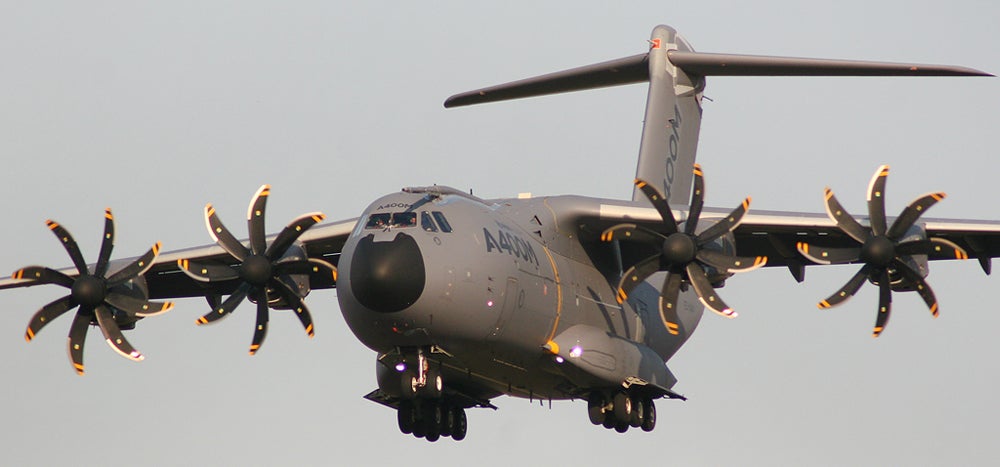
A view of the A400M showing the counter-rotating propellers
To negate control problems from engine torque, the A400M features !!!error: Indecipherable SUB-paragraph formatting!!! , but the opposite rotation direction is not derived by making two different engines. Rather, all the engines turn in the same direction, while propeller direction on two of the engines is reversed through the use of a gearbox. This allows for commonality among all four engines which simplifies maintenance and reduces cost. Airbus Military states that the Atlas has a range of over 5,000 miles at an altitude of 37,000 feet with a maximum payload of 81,000 pounds, or nearly twice that of the C-130J. It also features autonomous cargo loading and unloading which permits cargo transfer to be carried out by a single loadmaster. As with any new, complex aircraft, delays pushed the delivery dates farther and farther back, with initial deployment deferred from 2009 to 2012. The French Air Force completed the first operational mission of the A400M in December of 2013 in support of !!!error: Indecipherable SUB-paragraph formatting!!! in Mali, and the British made their first operational flight in 2015 with a mission to RAF Akrotiri in Cyprus. The A400M suffered its first fatal accident in May 2015 when engine mapping software was inadvertently erased and the engines failed to provide power during takeoff. Four employees of Spanish Airbus were killed, and two were seriously injured. A total of 174 aircraft have been ordered so far, with 32 deliveries completed as of December 1, 2016. (Photo by Tim Felce via Wikimedia Commons; Photo by Curimedia via !!!error: Indecipherable SUB-paragraph formatting!!! )
!!! UNKNOWN CONTENT TYPE !!!
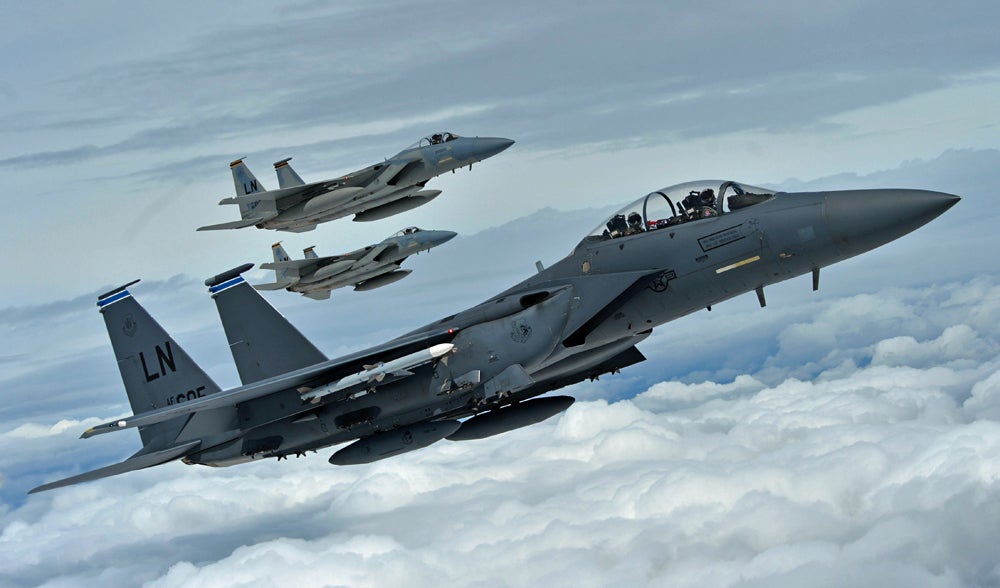
December 11, 1986 – The first flight of the McDonnell Douglas F-15E Strike Eagle. In the late 1960s, the US Air Force began looking for a new fighter to replace the !!!error: Indecipherable SUB-paragraph formatting!!! , a search which ended with the !!!error: Indecipherable SUB-paragraph formatting!!! . The Eagle was designed from the outset as an air superiority fighter, meaning that it would take command of the airspace over the battlefield and maintain control of it. But the Air Force made sure that the Eagle was strictly an air-to-air platform, and the F-15 Special Projects Office vehemently opposed the idea of the Eagle directly supporting troops on the ground, or taking part in air-to-ground missions, saying, “Not a pound for air to ground.” After all, the !!!error: Indecipherable SUB-paragraph formatting!!! , arguably one of the greatest ground attack aircraft ever produced, was getting ready to join the Air Force, and took its maiden flight in 1972 along with the Eagle. But in spite of no official support for a ground attack version of the Eagle, McDonnell Douglas worked quietly on an advanced, multi-role version of the Eagle in the hopes that opinions in the Air Force might change. In 1981, the Air Force announced the Enhanced Tactical Fighter program to find a replacement for the !!!error: Indecipherable SUB-paragraph formatting!!! . The goal was to develop a fighter that could strike deep into enemy territory without requiring fighter escort or electronic jamming provided by additional aircraft, and would also have the ability to defend itself from aerial attack. General Dynamics responded with the !!!error: Indecipherable SUB-paragraph formatting!!! , a cranked delta version of their successful !!!error: Indecipherable SUB-paragraph formatting!!! , and McDonnell Douglas rolled out the F-15E they had been working on.
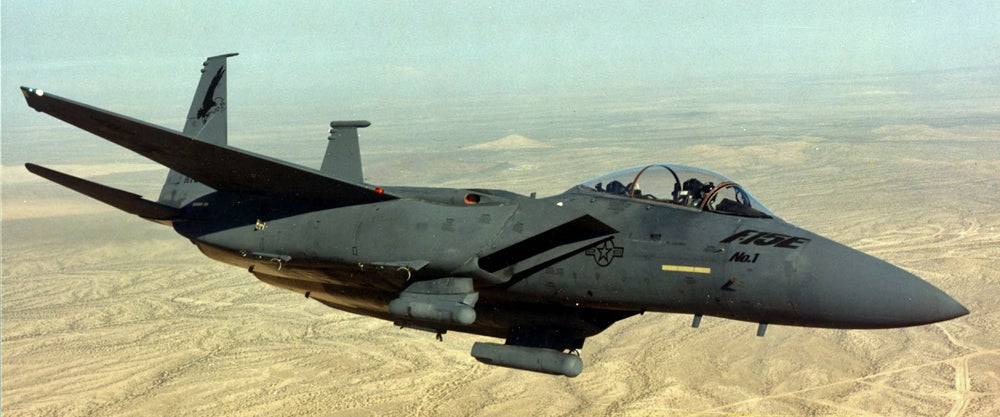
The first production F-15E Strike Eagle
After a two-year evaluation, the Air Force selected the F-15E, which proved to be capable of takeoff weights in excess of 75,000 pounds and had the ability to operate with 16 different weapon configurations. Other factors in the Air Force’s decision were the reduced development costs, future growth potential, and the added safety of two engines. The F-15E is very similar in appearance to the original F-15, but the most apparent difference is the addition of a second seat for the !!!error: Indecipherable SUB-paragraph formatting!!! (WSO) and a darker camouflage pattern. The fuselage was redesigned and strengthened to accept more powerful !!!error: Indecipherable SUB-paragraph formatting!!! afterburning turbofan engines, and !!!error: Indecipherable SUB-paragraph formatting!!! were added to the sides of the fuselage to extend range. And, unlike other two-seat aircraft with a WSO, such as the !!!error: Indecipherable SUB-paragraph formatting!!! , the rear seat has controls to fly the plane if necessary. The Strike Eagle was introduced in 1988, and soon saw action in the skies over Iraq and Kuwait in !!!error: Indecipherable SUB-paragraph formatting!!! , and has gone on to fight in all major operations since. The F-15E remains in production, with over 420 built, and in addition to its service with the US Air Force, the Strike Eagle also flies for the air forces of Israel, South Korea, Saudi Arabia and Singapore. (US Air Force photos)
!!! UNKNOWN CONTENT TYPE !!!
Short Takeoff
!!! UNKNOWN CONTENT TYPE !!!
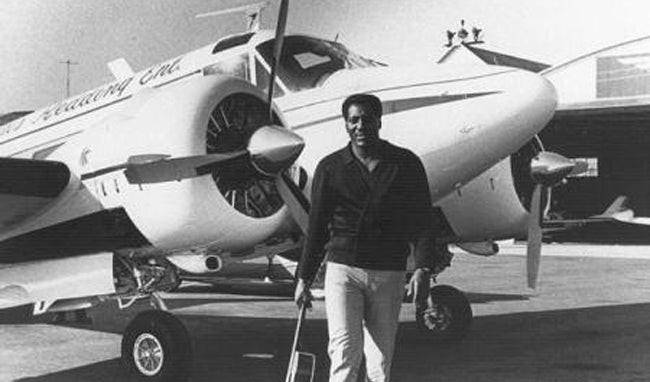
December 10, 1967 – Singer Otis Redding is killed in an air crash. Redding and his band, the Bar-Kays, were traveling from Cleveland, Ohio to Madison, Wisconsin in Redding’s !!!error: Indecipherable SUB-paragraph formatting!!! . While flying in heavy rain and fog, the aircraft crashed into a lake three miles short of the runway at Truax Field in Madision, killing the pilot and six of the seven passengers. The only survivor was band member Ben Cauley. The official NTSB accident report lists the cause of the crash as “undetermined.” (Photo author unknown)
!!! UNKNOWN CONTENT TYPE !!!
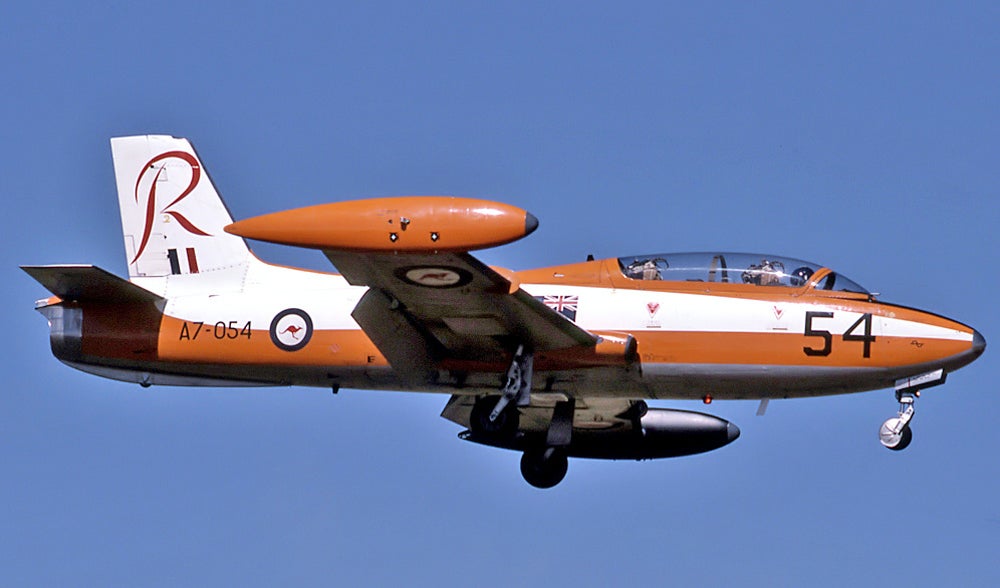
December 10, 1957 – The first flight of the Aermacchi MB-326. Without the means to produce supersonic aircraft following WWII, Italian designers focused on subsonic training and attack aircraft. The simple design of the MB-326 was both rugged and agile, and proved to be an ideal platform for all phases of jet pilot training. Initial production aircraft were powered by a single !!!error: Indecipherable SUB-paragraph formatting!!! turbojet, the MB-326 proved to be an extremely successful design, and, with 800 aircraft produced, the MB-326 alone accounts for 10 percent of all aircraft ever built by Aermacchi. Developed as both a trainer and attack jet, the MB-326 served 16 countries, with the final aircraft being retired by Brazil in 2010. (Photo by Daniel Tanner via !!!error: Indecipherable SUB-paragraph formatting!!! )
!!! UNKNOWN CONTENT TYPE !!!
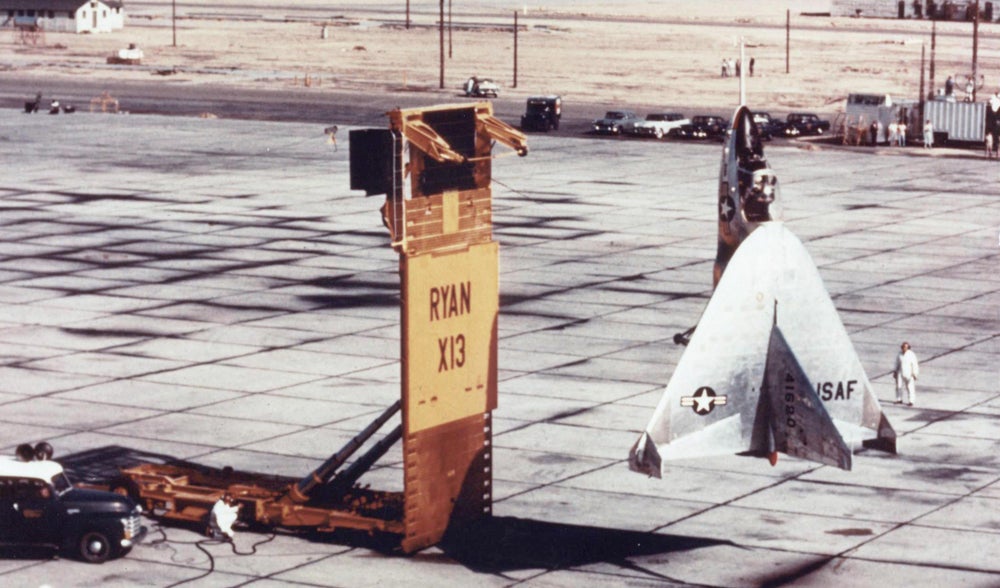
December 10, 1955 – The first flight of the Ryan X-13 Vertijet. In order to investigate the feasibility of launching an aircraft vertically from a submarine, designers at !!!error: Indecipherable SUB-paragraph formatting!!! developed the X-13 to test the concept. The aircraft would be required to take off vertically, transition to level flight, then return to hover and land using only the rear engine. Two were built, and the first aircraft was fitted with a tricycle landing gear to test general flight characteristics. Subsequent tests proved that the aircraft could take off and land vertically, and the first takeoff, transition to horizontal flight, and return to vertical landing took place in 1957. While flight tests proved that such an arrangement was possible, the project was canceled for lack of an operational requirement. (US Air Force photo)
!!! UNKNOWN CONTENT TYPE !!!

December 10, 1941 – Japanese aircraft sink the Royal Navy battleship HMS Prince of Wales and battlecruiser HMS Repulse. !!!error: Indecipherable SUB-paragraph formatting!!! and !!!error: Indecipherable SUB-paragraph formatting!!! were part of !!!error: Indecipherable SUB-paragraph formatting!!! , a naval squadron sent to intercept Japanese shipping in the waters off Singapore early in WWII. Royal Navy Admiral !!!error: Indecipherable SUB-paragraph formatting!!! , in command of the squadron, decided to sail without air cover, and the ships were attacked by land-based Japanese Navy !!!error: Indecipherable SUB-paragraph formatting!!! and !!!error: Indecipherable SUB-paragraph formatting!!! aircraft carrying a mix of bombs and torpedoes. Both Prince of Wales and Repulse were hit by four torpedoes, and both sank with heavy loss of life. The attack marked the first time in history that air power had sunk capital ships that were actively fighting to defend themselves, and heralded the end of the battleship as the primary weapon of naval surface warfare. (Illustration artist unknown)
!!! UNKNOWN CONTENT TYPE !!!
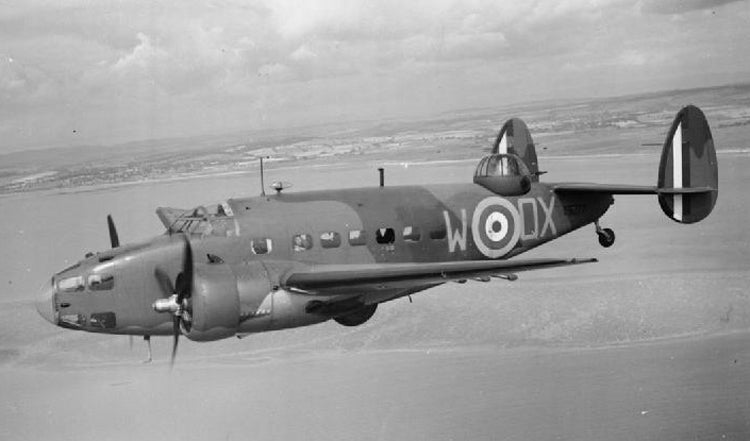
December 10, 1938 – The first flight of the Lockheed Hudson. A development of the !!!error: Indecipherable SUB-paragraph formatting!!! , the Hudson was built primarily for the Royal Air Force for use as a coastal reconnaissance aircraft, light bomber and in the anti-submarine warfare role. With the RAF’s initial order of 200 aircraft, the Hudson was the first major production aircraft for the !!!error: Indecipherable SUB-paragraph formatting!!! , and they eventually produced nearly 3,000 Hudsons for the RAF, the Royal Canadian Air Force, the Royal Australian Air Force and the US Army Air Forces. Hudsons served throughout the war in both Europe and the Pacific, and to be very agile fighters in the hands of a skilled pilot. (British government photo)
!!! UNKNOWN CONTENT TYPE !!!
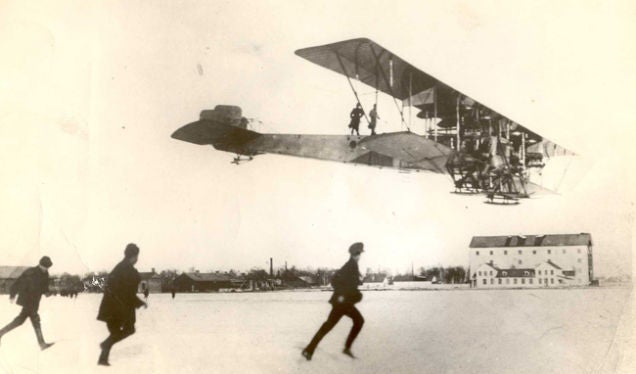
December 11, 1913 – The first flight of the Sikorsky Ilya Muromets , a large, four-engine bomber designed by Igor Sikorsky and developed from the earlier !!!error: Indecipherable SUB-paragraph formatting!!! . Named after a hero from Russian mythology and originally intended as a large passenger aircraft, the Ilya Muromets was developed into a bomber as WWI approached, and, by 1918, 83 bombers had been produced. They were the first aircraft in aviation history to perform heavy bombing missions, group raids, night bombings and photo reconnaissance. In 400 sorties, the Ilya Muromets dropped sixty-five tons of bombs. Following the war, the Muromets returned to its original role of passenger aircraft and mail plane, with the final flight taking place in 1922. (Photo author unknown)
!!! UNKNOWN CONTENT TYPE !!!
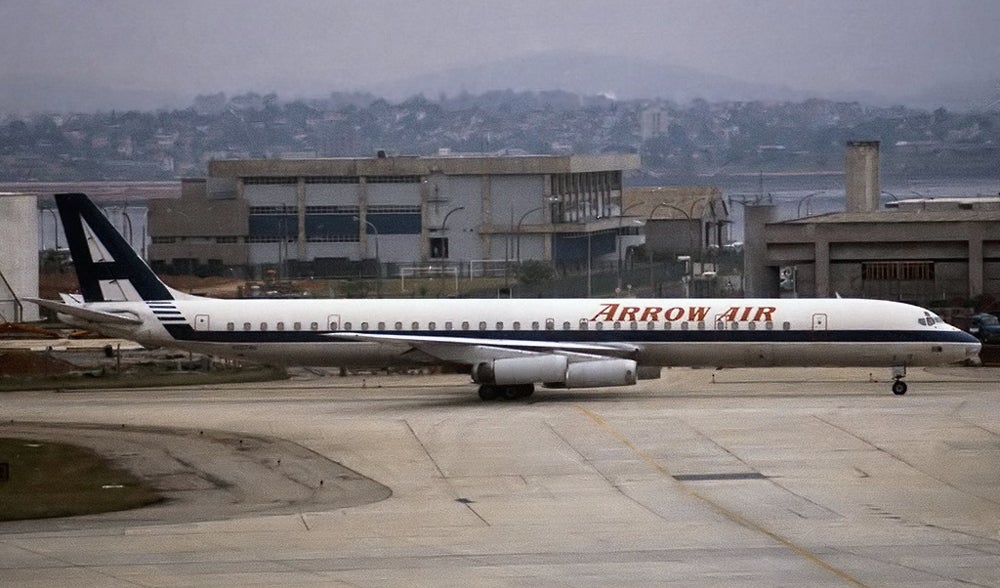
December 12, 1985 – The crash of Arrow Air Flight 1285, a chartered !!!error: Indecipherable SUB-paragraph formatting!!! (N950JW) that was carrying 8 crew members and 248 soldiers of the US Army !!!error: Indecipherable SUB-paragraph formatting!!! returning to Fort Campbell, Kentucky after serving in a peacekeeping mission in the Sinai Peninsula. On the final leg of the flight, the DC-8 crashed shortly after takeoff from Gander, Newfoundland, killing all on board. The investigation concluded that the crash was caused by the accumulation of ice on the wings, as well as incorrect weight calculations. However, some investigators dissented, saying that a fire or explosive device likely caused the crash. The accident remains the deadliest single peacetime loss of life in the history of the US Army and the worst crash on Canadian soil. (Photo by Pedro Aragão via !!!error: Indecipherable SUB-paragraph formatting!!! )
!!! UNKNOWN CONTENT TYPE !!!

December 12, 1979 – The first flight of the Sikorsky SH-60B Seahawk (or Sea Hawk), a navalized variant of the !!!error: Indecipherable SUB-paragraph formatting!!! utility helicopter originally developed for the US Army. Developed to replace the !!!error: Indecipherable SUB-paragraph formatting!!! , the SH-60 shares 83% commonality with its Army predecessor, with the most significant structural difference being a hinged tail for on-deck storage. The Seahawk also differs by the addition of !!!error: Indecipherable SUB-paragraph formatting!!! main gear struts, the shifting forward of the tail wheel, and a more powerful engine. Capable of serving from any air-capable ship, the Seahawk is designed for anti-submarine warfare, anti-surface warfare, naval special warfare, search and rescue, vertical replenishment and medical evacuation. Further variants have replaced the !!!error: Indecipherable SUB-paragraph formatting!!! and !!!error: Indecipherable SUB-paragraph formatting!!! . (US Navy photo)
!!! UNKNOWN CONTENT TYPE !!!

December 12, 1951 – The first flight of the de Havilland Canada DHC-3 Otter. With the DHC-2 Beaver, de Havilland Canada had built a reputation for rugged aircraft that were capable of taking off from short or unimproved airstrips, and the DHC-3 Otter was designed to be a larger and more powerful aircraft that could perform the same mission. Originally called the King Beaver, the DHC-3 is longer and heavier than the DHC-2, and can seat 10-11 passengers. Originally fitted with a !!!error: Indecipherable SUB-paragraph formatting!!! !!!error: Indecipherable SUB-paragraph formatting!!! geared radial engine, some Otters have been upgraded with a turboprop engine and are known as the Turbo Otter. The Otter is capable of operating from land, from sea with floats, or from snow with skis, and 466 Otters were produced from 1951-1967. (Photo by CanadianBushPilot via !!!error: Indecipherable SUB-paragraph formatting!!! )
!!! UNKNOWN CONTENT TYPE !!!
Recent Aviation History Posts
!!! UNKNOWN CONTENT TYPE !!!
!!! UNKNOWN CONTENT TYPE !!!
!!! UNKNOWN CONTENT TYPE !!!
!!! UNKNOWN CONTENT TYPE !!!
!!! UNKNOWN CONTENT TYPE !!!
!!! UNKNOWN CONTENT TYPE !!!
If you enjoy these Aviation History posts, please let me know in the comments. And if you missed any of the past articles, you can find them all at !!!error: Indecipherable SUB-paragraph formatting!!! .
!!! UNKNOWN CONTENT TYPE !!!
 Krieger (@FSKrieger22)
> ttyymmnn
Krieger (@FSKrieger22)
> ttyymmnn
12/13/2016 at 12:50 |
|
Speaking of HMS Prince of Wales and HMS Repulse, if you’re inclined towards diving, you might want to see them before they’re completely gone . South East Asians give zero shits about historical sites unless they’re politically expedient...
 E90M3
> ttyymmnn
E90M3
> ttyymmnn
12/13/2016 at 13:00 |
|
I don’t remember if you did these back in 2012 when I was active here, but since coming back I’ve thoroughly enjoyed these.
I had no idea that Otis Redding was killed in a plane crash.
I had an interview with Sikorsky a few months ago for a quality engineer position, that I didn’t get, but I did get a tour of the production facility in Troy Alabama where they make the UH-60. I had no idea they’re made entirely by hand.
 RallyWrench
> Krieger (@FSKrieger22)
RallyWrench
> Krieger (@FSKrieger22)
12/13/2016 at 13:15 |
|
That is some bullshit.
 user314
> ttyymmnn
user314
> ttyymmnn
12/13/2016 at 13:26 |
|
Much as I like the Mud Hen, I still kinda wish the F-16XL had reached production.
 Roundbadge
> ttyymmnn
Roundbadge
> ttyymmnn
12/13/2016 at 13:26 |
|
Those dudes standing on the tail of the Sikorsky in flight appear to give a sum total of zero effs.
 ttyymmnn
> user314
ttyymmnn
> user314
12/13/2016 at 13:30 |
|
Me too. It was a sexy beast.
 ttyymmnn
> E90M3
ttyymmnn
> E90M3
12/13/2016 at 13:31 |
|
February will mark 2 years of these posts, but I’m planning on calling it quits at the end of December. I’ll be doing other sorts of posts, though.
Thanks for reading.
 ttyymmnn
> Krieger (@FSKrieger22)
ttyymmnn
> Krieger (@FSKrieger22)
12/13/2016 at 13:32 |
|
No, I’ll never be a diver. I have an intense fear of drowning. But it would be interesting to see the wrecks.
 user314
> ttyymmnn
user314
> ttyymmnn
12/13/2016 at 14:53 |
|
Landing an operational derivative of the X-13 on a rolling ship, or with a damaged airplane, would have been a nightmare. Some ideas just don’t work.
 ttyymmnn
> user314
ttyymmnn
> user314
12/13/2016 at 16:06 |
|
Back in the day when there was enough Cold War money to do stuff just to see if it could be done.
 user314
> ttyymmnn
user314
> ttyymmnn
12/13/2016 at 16:48 |
|
Especially if we could strap a nuke on it, or better yet, power it with nukes and strap nukes to it! See also, Project Pluto , Project Rover , the X-6 / NB-36H , NERVA , the B-72/WS-125 ...
 AuthiCooper1300
> ttyymmnn
AuthiCooper1300
> ttyymmnn
12/13/2016 at 19:13 |
|
About the HMS Prince of Wales ... a while ago I read that in 2002 the Royal Navy had her bell recovered in a bit of a hurry, after persistent and credible rumours that a third party intended to pay some divers to get it and take it to the HQ of a big industrial concern in Japan – as a sort of secret war trophy.
Oh, forgot to add - excellent selection and writeup as usual!
 facw
> ttyymmnn
facw
> ttyymmnn
12/13/2016 at 19:20 |
|
The memory of WWII was still pretty fresh. A fighter that could launch from a destroyer or freighter to defend a convoy would have been useful. And you can bet Prince of Wales and Repulse would have liked to have been able to send up even a few fighters to defend them.
 facw
> AuthiCooper1300
facw
> AuthiCooper1300
12/13/2016 at 19:25 |
|
Maybe nothing that fancy. These wrecks are being pillaged by scrappers in general. These guys are thus far too big to move away completely, but they have been damaged. Most of the wrecks from the Battle of the Java Sea are completely gone, with only USS Houston relatively intact (though also damaged by illegal salvage operations).
 AuthiCooper1300
> facw
AuthiCooper1300
> facw
12/13/2016 at 19:39 |
|
I read that item way before there was any information about the locals starting snatching metal from them. I cannot remember whether it was an early version of the Wikipedia entry on the PoW or maybe a BBC News item. I must say I was quite horrified.
Have a look here:
http://www.forcez-survivors.org.uk/news/shipsbells.html
Incidentally, that Telegraph article mentioned by Mr Krieger contains the following paragraph:
But having stripped the wrecks of those components, the scavengers have now started to take
other ferrous metals, primarily brass and copper,
as well as large chunks of steel, such as the propellor shafts, and high-grade aluminium.
An overworked subeditor, perhaps?
 You can tell a Finn but you can't tell him much
> ttyymmnn
You can tell a Finn but you can't tell him much
> ttyymmnn
12/14/2016 at 12:05 |
|
NNNNOOOOOOOO!!!!!!!!!! Where will I get my Oppo airplane fix????? You can’t just cut off an addict cold turkey like that.
 You can tell a Finn but you can't tell him much
> ttyymmnn
You can tell a Finn but you can't tell him much
> ttyymmnn
12/14/2016 at 12:08 |
|
It always blows my mind to see the MTOW’s of modern fighters. The fact that the F-15E has an MTOW greater than the B-17 is crazy. I wonder how many B-17's it would take to match the combat effectiveness of one F-15E, or if they even could.
 ttyymmnn
> You can tell a Finn but you can't tell him much
ttyymmnn
> You can tell a Finn but you can't tell him much
12/14/2016 at 12:30 |
|
I would love to keep going, but January-March are going to be extremely busy for me, and keeping up with 2 posts a week, even with recycling material, is getting burdensome. I’m going to move to weekly posts about interesting and obscure aircraft, aircraft also-rans, and important figures. I’ve already got a bunch of things I want to write about.
 ttyymmnn
> You can tell a Finn but you can't tell him much
ttyymmnn
> You can tell a Finn but you can't tell him much
12/14/2016 at 12:31 |
|
Dropping unguided dumb bombs, they likely never could.
 You can tell a Finn but you can't tell him much
> ttyymmnn
You can tell a Finn but you can't tell him much
> ttyymmnn
12/14/2016 at 13:30 |
|
These have been awesome posts to read, but I can definitely appreciate the amount of work that goes into it. Especially churning them out twice a week.
 ttyymmnn
> You can tell a Finn but you can't tell him much
ttyymmnn
> You can tell a Finn but you can't tell him much
12/14/2016 at 13:55 |
|
I’m barely keeping up right now. It will get easier next week when my boys are out of school. But I’ve got some heavy concerts to prepare for after the new year, and the 1-2 hours each morning I spend on these will be better spent practicing. Posting one topic, once a week, will be significantly easier. Thanks for the kind words, and thanks for reading.
 gmporschenut also a fan of hondas
> ttyymmnn
gmporschenut also a fan of hondas
> ttyymmnn
12/14/2016 at 23:26 |
|
Such a huge loss
 ttyymmnn
> gmporschenut also a fan of hondas
ttyymmnn
> gmporschenut also a fan of hondas
12/14/2016 at 23:51 |
|
Agreed, but he shouldn’t have been flying that day.
 e36Jeff now drives a ZHP
> ttyymmnn
e36Jeff now drives a ZHP
> ttyymmnn
12/15/2016 at 19:15 |
|
no, they could, but it took thousand plane formations to do the work of maybe 2 F-15E’s.